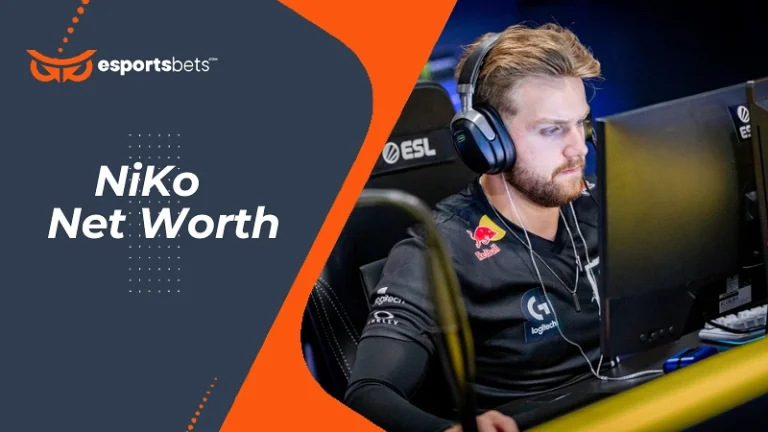Will Esports Be Bigger Than Sports?
Once upon a time, the idea of ‘esports’ was almost laughable; a niche concept confined to the backrooms of gaming stores and the basements of those ridiculed for their passion. Today, the esports industry is a titan, a thriving, diverse, and valuable ecosystem that has risen to become dramatically popular and remarkably lucrative for players, organisations, and brands investing in the space. But, behind all this growth, is there the potential for esports to be bigger than sports?
Does Esports Have A Future?
In 2022, amidst a global economic downturn, many esports organisations are making drastic cuts. It’s a fight for survival in an industry that is still in the earliest stages of formation and exploration, and it’s a set of circumstances that has hit some companies very hard. However, despite the struggles experienced by the community at large, esports remains relatively resilient as an industry, and numbers are still set to climb.
According to Statista.com, the esports market revenue is set to grow at a consistent rate:
- 2020: $996 million
- 2021: $1.13 billion
- 2022: $1.38 billion
- 2025: $1.86 billion
The platform also expanded on the growth of the audience itself, looking at those actually consuming the content:
- 2020: 435 million, 220.5 million ‘enthusiasts’
- 2021: 499.5 million, 249.5 million ‘enthusiasts’
- 2022: 532.1 million, 270.9 million ‘enthusiasts’
- 2025: 640.8 million, 322.7 million ‘enthusiasts’
Given that there are an estimated 2 billion gamers in the world, there’s plenty of fuel to keep that competitive fire stoked for many years to come, and in some respects, gaming as an industry still has a lot of growing to do.

Are People Still Watching Esports Tournaments?
When it comes to esports as an industry, one of the largest portions of revenue is derived from tournament streaming. This is an incredibly lucrative area, and as time goes on, broadcasting platforms are paying much more for exclusive rights to some of the world’s grandest esports tournaments. In 2020, Activision Blizzard signed a three-year deal with Google worth $160 million, locking the Overwatch League into a partnership with YouTube.
It’s also extremely important to highlight that, over time, viewership figures are skyrocketing. From the Call of Duty League to The International, viewership numbers are strong and, typically, they’re only getting stronger. According to escharts.com, some tournaments have experienced unbelievable viewership growth in the last few years:
- Free Fire World Series 2021 – 5.4 million peak
- 2021 League of Legends World Championship – 4.01 million peak
- 2019 League of Legends World Championship – 3.9 million peak
- PUBG Mobile Global Championship Season 0 – 3.8 million peak
- M3 World Championship – 3.1 million peak
- PGL Major Stockholm – 2.7 million peak
With esports streaming, a huge booster comes from how interactive platforms like Twitch and YouTube really are. In 2020, CEO of Streamlabs, Ali Moiz, spoke about how effective the Twitch platform has been at uniting audiences, creators, and competitors:
They’ve (Twitch) found a really unique way to facilitate real-time reactions between the audience and the creator. No other platform has done this quite as well. It’s exciting for people to donate to their favorite Twitch streamer and hear them call you out live on stream in front of thousands of people. That kind of interaction is addicting.
Can Esports Be Bigger Than Sports?
At this point, it’s almost impossible to see a future where esports is bigger than traditional sports. While the esports industry can grow to epic proportions, it’ll likely never rival the traditional sports industry. For millennia, the human race has relied on sports as a means of competition, entertainment, and for many millions of athletes, a lifelong career.
By comparison, the esports industry has existed in its current form for little more than a decade. While technology is becoming increasingly capable and fantastic, and we as a species are relying on it and exploring it more with each passing day, it’s unrealistic to think that, at any point soon, esports will overtake traditional sports.
It’s estimated that the global sports industry will grow to a value of around $350 billion by 2031. By the same time, the esports industry is expected to be worth around $3.5 billion, suggesting immediately that the esports vertical is worth a mere 10% of the value of the sports industry. As time goes on and both industries grow at an exponential rate, it stands to reason that esports will forever be playing catch-up.
In terms of viewership, this is how many viewers have been recorded tuning in to the most popular sporting events:
- Olympic Games – 4.7 billion
- FIFA World Cup – 3.5 billion
- Tour de France – 3.4 billion
- Rugby World Cup – 857 million
- Super Bowl – 114.4 million
Now, compare that to the total, global esports audience, which sits at around 500 million.
In terms of money, the highest-paid sports athlete in 2021 earned around $130 million, while the highest-paid esports player, Johan ‘N0tail’ Sundstein has earned $7 million in his entire career.
Ultimately, we should highlight that we’re addressing this question on a global scale. For instance, there are some niche sports that cannot even compete against some esports titles, and in some geographical regions, esports are king compared to traditional sports. But, on a global scale, esports isn’t going to overtake sports.

Why Can Esports Not Compete Against Sports?
Firstly, we’re not saying that esports cannot compete against traditional sports. It’s the complete opposite – esports is competing against sports every day, as there are so many similarities between the two industries. From the sponsorship potential to how the competitors train, and from the structure of tournaments to the broadcast styles, the two industries are almost identical.
If there’s one way in which the two industries differ, it’s in the demographic. Traditionally, the esports market is reserved more for younger, typically male viewers, with an interest in technology and a more direct connection to the games themselves. However, the sports industry is open to a much wider demographic, attracting viewers of all ages, all walks of life, and with all manner of mixed interests.
This area was addressed by Premier League Governance Manager, Matt Segal, in 2019:
It’s got quite a lot to do with issues around engaging 18-26 year olds. Sports are starting to realise that to capture this market, esports may play a key role, and therefore traditional sports and particularly sports clubs are starting to welcome esports into the fold.
There are several unfortunate hurdles and challenges for the esports industry to overcome before it can successfully and truly rival the sports industry. For instance, as we’ve just mentioned, if a viewer isn’t interested in video games, there’s almost no hope of drawing them into the industry. There’s a level of complexity present in the esports industry when it comes to the games themselves, particularly when it comes down to understanding exactly what you’re looking at.
For instance, a first-time viewer of a League of Legends tournament with no familiarity with the game would be absolutely lost. By contrast, someone watching a soccer game for the first time might not understand the more niche rules and regulations of the game, but it’s an instantly recognisable Team A vs. Team B format that is digested remarkably easily. Similarly, when it comes to esports betting, bettors will not gamble on an esports tournament that they’re not familiar with, for the simple reason that they just don’t get it.
When it comes to broadcasting, sports always take pride of place on the biggest outlets and channels. Conversely, esports are traditionally confined to YouTube or Twitch. For traditional sports competitors, sponsorship and endorsement deals are readily available, while esports organisations have more restricted selections when it comes to the marketing angle. Many esports organisations must rely on intense content creation efforts to grow their audience, while, arguably, the sports industry effortlessly markets itself.
The Opportunity With Esports Betting

Outside of viewership, tournaments, and sponsorship deals, one of the most valuable portions of the esports industry is the esports betting market. This is where the esports industry may just be sharpening an edge over the sports industry, as there are near endless possibilities for betting in esports. At any given point, there are matches all over the world, being watched for free by absolutely anyone. Even if a bettor isn’t familiar with esports as an industry, there’s the potential to tune in for the grand price of absolutely nothing and learn a little more about it.
As technology advances, esports betting is becoming an increasingly lucrative and well-developed space. In recent years, for example, we’ve seen fusions between the esports and the cryptocurrency industries. Today, many esports betting sites have cryptocurrency integrations that allow technologically-minded individuals to bet on esports tournaments using cryptocurrency funds.
Here’s a representative example of the growth of the esports betting market in terms of overall value (from Business of Esports):
- 2020 – $12.6 billion value
- 2027 – $20.7 billion value
- CAGR – 13.1% during the forecast period
During the COVID-19 pandemic, when traditional sports suffered immeasurably, esports went online, and millions of bettors and fans flocked to watch these tournaments, using them to place their wagers. If sports should ever be shut down again, esports will effortlessly climb back to the top, aided immeasurably by the betting factor.
Is It Worth Investing In Esports At All?
For those thinking that this analysis is aimed at dealing a blow against the esports industry, it’s important to stress that this isn’t the case. There’s a fantastic wealth of opportunity currently exploding from within the very core of the esports industry, and it’s growing at a remarkable rate on a global scale. From esports stadiums to organisations being listed on the NASDAQ, the industry is going from strength to strength, even if it currently sits leagues behind the traditional sports industry.

Ultimately, it’s worth highlighting that, in truth, the esports industry doesn’t need to compete with the sports industry. While it’s unlikely to be as big as traditional sports anytime soon, it’s growing well in its own right, pulling in millions of viewers and expanding with each passing year. Reportedly, younger audiences are losing interest in traditional sports, particularly as the esports industry expands and more value is revealed to the younger competitor.
In a statement, Carlos Rodriguez, CEO of G2 Esports, spoke on the idea that many companies simply aren’t aware of the growing value in gaming:
If traditional companies don’t understand why video games are the largest entertainment industry in the world right now, then there has to be a shift.
He also went on to highlight that ‘traditional sports’ are too reliant on the big stars – the celebrity personalities.
If you get LeBron James tomorrow as a player, you don’t have to create a single piece of content about your team. You will automatically sell millions of jerseys. Period. We very often get compared with traditional sports teams, and I think that comparison does a disservice to what an esports organisation really is about.
For the most part, many organisations in the business understand that the esports industry is just getting started. If we allow it to unravel for as long as the sports industry has, could we see it ultimately become the largest entertainment medium in the world?
Check back with us after a century or two, and we’ll see what the comparison looks like.







